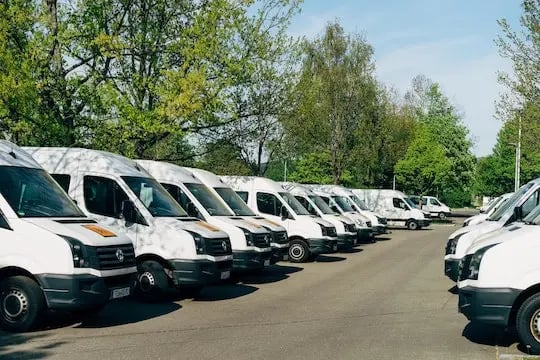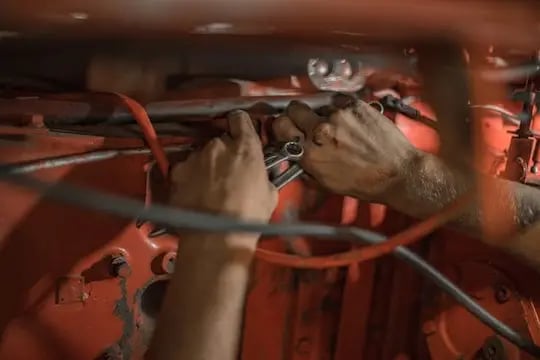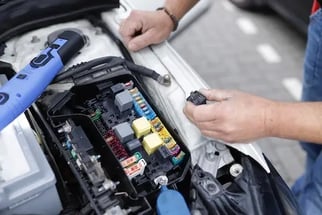Welcome to The Fleet Manager's Handbook, a comprehensive resource for fleet professionals looking to improve their operations and achieve top-performing results. In this blog, you'll find expert tips and strategies for managing and maintaining a high-performing fleet and best practices for optimizing efficiency and reducing costs. Whether you're a seasoned fleet manager or new to the field, this blog has something for everyone. Stay up-to-date with industry insights and trends, and learn how to take your fleet management skills to the next level.
The best-managed fleets employ a range of strategies and best practices for maximizing the efficiency and effectiveness of a fleet of vehicles. This includes the following:
- Implementing GPS tracking technology
- Investing in regular maintenance
- Optimizing routes and schedules
- Providing driver training and support
- Implementing fuel management strategies
- Monitoring and analyzing data
- Collaborating with other businesses and organizations

Implementing GPS tracking technology
GPS tracking can provide real-time information about the location and movement of vehicles, allowing businesses to monitor their fleet and make informed decisions about how to best allocate their resources. GPS tracking technology empowers businesses to monitor their fleet and make informed decisions about allocating their resources best.
When using GPS tracking technology to monitor their fleet, fleet manager's evaluate the top GPS tracker companies and choose a GPS tracking system that is suitable for their needs. This may involve considering factors such as the number of vehicles in the fleet, the type of vehicles, the features and capabilities of the tracking system, and the cost.
Install the GPS tracking devices on each vehicle in the fleet, following the instructions provided by the manufacturer or service-provider. This may involve attaching the devices to the vehicles' OBD port or using the included wiring. Each tracker is different (which is why we always recommend interested fleet managers speak with one of our reps rather than take an online quiz).
Once installed, activate the GPS tracking devices and allow the devices to begin transmitting location data to the user.
Monitor the location and movement of the vehicles in real-time using the tracking software. This involves logging in to the web-based interface or downloading the mobile app to access the tracking data.
Using the tracking data to make informed decisions involves:
- Identifying patterns of usage.
- Identifying areas where vehicles may be idle or underutilized.
- Using the data to make other decisions about optimizing the fleet's performance.
By providing real-time information about the location and movement of their vehicles, GPS tracking systems can help businesses improve the efficiency of their fleet and make more effective use of their resources.
Explore the Linxup GPS Trackers: OBD GPS | Wire-in GPS | Jbus GPS | Daily Tracker ATLT | Wired Tracker AT3 | Dash Cam + GPS
Investing in regular maintenance
Regular maintenance is essential for ensuring that vehicles are running at peak performance and can help to prevent costly breakdowns and downtime. This includes routine inspections, oil changes, tire rotations, and more comprehensive repairs and upgrades as needed.
In addition to using GPS tracking technology and other tools, the best-managed fleets prioritize regular maintenance and inspections. This involves regularly checking and servicing critical components of the vehicles, such as the engine, transmission, brakes, and other systems ensure that they are in good working order. The goal is to proactively identify and address any potential issues before they become serious problems.
Some common types of regular maintenance and inspections that are performed on the best-managed fleets include oil changes, tire rotations, and brake inspections.
Oil changes
Regularly changing the oil in a vehicle is essential to maintaining its performance and longevity. By periodically changing the oil, businesses can ensure that their cars are running smoothly and efficiently, and can also help to prevent issues such as engine wear and overheating.
Tire rotations
Rotating the tires regularly ensures that they wear evenly and last longer. By rotating the tires, businesses can also improve the handling and stability of their vehicles and can reduce the risk of accidents and other issues.
Brake inspections
Regular inspections of the brakes are essential for ensuring that they are in good working order and can safely stop the vehicle. By regularly inspecting the brakes, businesses can identify and address any potential issues, such as worn pads or rotors, and can ensure that their cars are safe and reliable.
Comprehensive repairs and upgrades
In addition to regular maintenance and inspections, the best-managed fleets prioritize comprehensive repairs and upgrades as needed. This may involve replacing worn or damaged parts or upgrading to newer and more efficient components to improve the vehicles' performance and reliability. By investing in regular repairs and upgrades, businesses can ensure that their cars are always in good working order and can perform at their best.
The best-managed fleets prioritize regular maintenance and inspections as a crucial part of their operations. By regularly checking and servicing their vehicles, businesses can ensure that they are running smoothly and efficiently and prevent potential issues from becoming serious problems. By investing in regular maintenance and inspections, companies can improve the performance and reliability of their fleet and can better serve the needs of their customers and stakeholders.
Optimizing routes and schedules
By analyzing the routes and schedules of vehicles, businesses can identify areas where they can save time and fuel. This may include consolidating trips, reducing idle time, and using more efficient routes.
In addition to regular maintenance and inspections, the best-managed fleets also prioritize strategies and tactics that can help improve their operations' efficiency and productivity. Some common strategies and tactics that are used by the best-managed fleets include consolidating trips, reducing idle time, and using more efficient routes.
Consolidating trips
By consolidating multiple deliveries or service calls into a single trip, businesses can reduce the time and fuel wasted on unnecessary travel. This can help improve their fleet's efficiency, reduce operating costs, and increase profitability.
Reducing idle time
Many fleet vehicles spend significant amounts of time idling while waiting for a delivery or service call or parked at a facility or depot. Businesses can save fuel, reduce emissions, and improve their fleet's overall performance by reducing idle time.
Using more efficient routes
By using GPS tracking technology and other tools, businesses can identify more efficient routes for their vehicles and avoid traffic congestion, construction delays, and other factors that can impact the speed and efficiency of their fleet. Businesses can use more efficient routes to reduce travel time and fuel consumption and improve their fleet's overall performance.
The best-managed fleets prioritize strategies and tactics that can help improve their operations' efficiency and productivity. By consolidating trips, reducing idle time, and using more efficient routes, businesses can save time and money and improve their fleet's performance and reliability. By adopting these strategies and tactics, businesses can gain a competitive advantage and can better serve the needs of their customers and stakeholders.
Providing driver training and support
Well-trained drivers are vital to the success of any fleet, and businesses should invest in regular training and support to ensure that their drivers have the skills and knowledge they need to operate safely and efficiently.
Some common types of training and support that are provided to drivers in the best-managed fleets include safety training, defensive driving training, vehicle operation training, and of course ongoing driver support and assistance when needed.
Safety training
Many fleet vehicles, such as commercial trucks and buses, are large and complex and require specialized knowledge and skills to operate safely. By providing regular safety training to their drivers, businesses can help to ensure that they are familiar with the unique challenges and hazards of operating these vehicles and can help to reduce the risk of accidents and other incidents.
Defensive driving training
Defensive driving training can help drivers to identify and avoid potential hazards on the road and can also help them to respond effectively to unexpected situations. By providing regular defensive driving training to their drivers, businesses can help to improve their safety and can also help to reduce the risk of accidents and other incidents.
Vehicle operation training
In addition to safety and defensive driving training, the best-managed fleets also provide regular training on the operation of the specific vehicles in their fleet. This may include training on the use of specific features and systems, such as GPS tracking technology, and can help to ensure that drivers are familiar with the unique capabilities and limitations of the vehicle.
Ongoing driver support and assistance
In addition to providing regular training and support to their drivers, the best-managed fleets also prioritize ongoing support and assistance to ensure that their drivers can perform their jobs effectively. This may include providing drivers access to resources and information, such as maps and route planning tools. It can also involve providing regular feedback and coaching to help drivers improve their performance.
By providing regular training and support to their drivers, businesses can help to ensure that they can operate their vehicles safely and efficiently and can also help improve the overall performance of their fleet. When there are special types of vehicles or ones that involve specialized training, this becomes even more important.

Implementing fuel management strategies
Fuel is often one of the most significant expenses for fleet managers, and businesses should implement strategies to reduce fuel consumption and save money. This may include using more fuel-efficient vehicles, optimizing routes, and encouraging drivers to adopt more fuel-efficient driving habits.
Some common strategies and tactics that are used by the best-managed fleets to manage fuel usage include using more fuel-efficient vehicles, optimizing routes, and encouraging new driver habits.
Using more fuel-efficient vehicles
One of the key ways that the best-managed fleets can improve their fuel efficiency is by using more fuel-efficient vehicles. This may involve investing in newer, more fuel-efficient cars or upgrading existing vehicles with more efficient engines and other components. By using more fuel-efficient vehicles, businesses can reduce their fuel consumption and can also reduce their operating costs, and increase their profitability.
Optimizing routes
Another key strategy used by the best-managed fleets to improve their fuel efficiency is optimizing their routes. This may involve using GPS tracking technology and other tools to identify the most efficient routes for their vehicles. It can also involve avoiding traffic congestion, construction delays, and other factors impacting fuel efficiency. Businesses can reduce travel time and fuel consumption by optimizing their routes and improving their fleet's overall efficiency.
Encouraging drivers to adopt more fuel-efficient driving habits
In addition to using more fuel-efficient vehicles and optimizing routes, the best-managed fleets also encourage their drivers to adopt more fuel-efficient driving habits. This may involve providing drivers with training on how to conserve fuel, such as by avoiding aggressive acceleration and braking. It can also include regular feedback and coaching to help drivers improve fuel-efficient driving techniques.
By encouraging drivers to adopt more fuel-efficient driving habits, businesses can further improve the fuel efficiency of their fleets. They can also reduce their operating costs and increase their profitability.

Monitoring and analyzing data
By collecting and analyzing data from GPS tracking systems, vehicle maintenance records, and other sources, businesses can gain valuable insights into the performance of their fleet and identify areas for improvement.
This may involve analyzing data from GPS tracking systems to identify trends and patterns in vehicle usage and can also involve analyzing vehicle maintenance records and other data to identify potential issues and opportunities for improvement.
Some common ways that the best-managed fleets use data analysis to improve their operations include identifying trends and patterns in vehicle utilization, potential issues and opportunities, as well as tracking the success of interventions.
Identifying trends and patterns in vehicle usage
By analyzing data from GPS tracking systems, the best-managed fleets can identify trends and patterns in vehicle usage, like the times of day when vehicles are used most or the routes most frequently traveled. This information can help businesses to understand the needs of their fleet better and can also help them to make more informed decisions about how to allocate their resources.
Identifying potential issues and opportunities for improvement
By analyzing data from vehicle maintenance records and other sources, the best-managed fleets can identify potential issues and opportunities for improvement. This may involve identifying trends in the types of repairs and maintenance performed on their vehicles or identifying patterns in the performance of specific vehicles or drivers. By using this information to identify potential issues and opportunities, businesses can take steps to prevent potential problems and capitalize on opportunities to improve the performance of their fleet.
Tracking the effectiveness of interventions
In addition to identifying potential issues and opportunities, the best-managed fleets also use data analysis to track the effectiveness of interventions and other actions taken to improve the performance of their fleet.
This may involve comparing data before and after an intervention, like the implementation of a new training program or the adoption of a new fuel-efficient driving technique, to measure the impact of the intervention. By tracking the effectiveness of interventions, businesses can determine which strategies and tactics are most effective and adjust their approach as needed.
Overall, the best-managed fleets prioritize data analysis as a critical part of their operations. By analyzing data from GPS tracking systems, vehicle maintenance records, and other sources, businesses can gain valuable insights into the performance of their fleet and take steps to improve the efficiency and effectiveness of their operations. By using data analysis to improve their fleet management, businesses can gain a competitive advantage and can better serve the needs of their customers and stakeholders.

Collaborating with other businesses and organizations
Collaborating with other businesses and organizations can help fleet managers to reduce costs, share resources, and gain access to valuable expertise and support. This may include partnering with other companies to share vehicles or working with organizations such as trade associations to access training and support.
In addition to using GPS tracking technology and other tools to manage their fleet, the best-managed fleets also prioritize collaboration with other businesses in order to help reduce costs, share resources, and gain access to valuable expertise and support. This may involve partnering with other businesses to share resources, such as vehicles or facilities, or collaborating with other companies to gain access to expertise and support that may not be available within their organization.
Sharing resources
By partnering with other businesses, the best-managed fleets can share resources and help reduce costs and improve efficiency. This may involve sharing vehicles, facilities, or other resources and can help businesses to optimize their operations.
Accessing expertise and support
By collaborating with other businesses, the best-managed fleets can gain access to expertise and support that may not be available within their organization. This may involve partnering with businesses that specialize in specific areas, such as fleet maintenance or driver training, and can help companies to improve their fleet performance and better serve the needs of their customers and stakeholders.
Developing new products and services
In addition to sharing resources and accessing expertise and support, the best-managed fleets may also collaborate with other businesses to develop new products and services. This may involve working with other businesses to identify and address unmet needs to serve their customers' needs.
The best-managed fleets prioritize collaboration with other businesses to help reduce costs, share resources and gain access to valuable expertise and support. By partnering with other companies, businesses can earn a competitive advantage and more effectively compete in the marketplace.
The best fleets are well-equipped, well-trained, and well-supported, using a range of strategies and best practices to maximize their efficiency and effectiveness. By implementing these strategies, businesses can ensure they are on their way to ranking among the best-managed fleets out there.
More importantly, you can reduce costs, improve performance, and ensure productivity in all aspects of fleet management. GPS tracking systems provide real-time information about the location and movement of vehicles, allowing businesses to monitor their fleet and make informed decisions about how to allocate their resources best.
Explore the range of Linxup GPS Trackers: Dash Cam + GPS, OBD GPS, Wire-in GPS, Jbus GPS, Daily Tracker ATLT, Wired Tracker AT3, and Solar Tracker or learn more about the solutions discussed in this article.
Reach out to us, click here on your phone or dial: 1-877-907-0801 to talk to a rep today.




